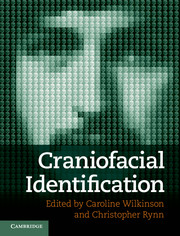Book contents
- Frontmatter
- Contents
- Contributors
- Part I Identification of the Living
- Chapter 1 Familiar face recognition
- Chapter 2 Unfamiliar face recognition
- Chapter 3 EFIT-V
- Chapter 4 Facial recall and computer composites
- Chapter 5 Facial ageing
- Chapter 6 Age progression and regression
- Chapter 7 Computer-assisted age progression
- Chapter 8 Facial recognition from identification parades
- Chapter 9 Virtual human identification line-ups
- Chapter 10 Computer-generated face models
- Chapter 11 Recognising and learning faces in motion
- Chapter 12 Facial image comparison
- Chapter 13 Three-dimensional facial imaging
- Part II Identification of the Dead
- Index
- Plate Section
- References
Chapter 5 - Facial ageing
Published online by Cambridge University Press: 05 May 2012
- Frontmatter
- Contents
- Contributors
- Part I Identification of the Living
- Chapter 1 Familiar face recognition
- Chapter 2 Unfamiliar face recognition
- Chapter 3 EFIT-V
- Chapter 4 Facial recall and computer composites
- Chapter 5 Facial ageing
- Chapter 6 Age progression and regression
- Chapter 7 Computer-assisted age progression
- Chapter 8 Facial recognition from identification parades
- Chapter 9 Virtual human identification line-ups
- Chapter 10 Computer-generated face models
- Chapter 11 Recognising and learning faces in motion
- Chapter 12 Facial image comparison
- Chapter 13 Three-dimensional facial imaging
- Part II Identification of the Dead
- Index
- Plate Section
- References
Summary
Introduction
In this chapter we outline current research into face ageing and explore both computational methods and perceived results. We describe methods to digitally alter an image of a human face of known age, such that the image becomes an estimation of the same person apparently aged by a set amount. This has many useful applications, from locating missing persons to improving identification systems to take ageing into account. It is also of interest to the cosmetics industry, to simulate and evaluate the effects of anti-ageing treatments, as well as the entertainments industry, for example to age an actor.
Previous research into synthetic face ageing has concentrated on transforming a two-dimensional (2D) image. These methods work by applying a shape and colour change to the input image, often based on a learned statistical model. Early methods such as cardioidal strain, were non-statistical and relied on the similarity between certain mathematical functions and large-scale biological changes (Pittenger and Shaw, 1975; Pittenger et al., 1975; Mark and Todd, 1983; Bruce et al., 1989). More recent researchers have used statistical modelling methods to derive a model from a set of training images (Lanitis et al., 2002; Scandrett et al., 2006). The primary variations in these methods have been the functions and methods used to train the model.
- Type
- Chapter
- Information
- Craniofacial Identification , pp. 57 - 67Publisher: Cambridge University PressPrint publication year: 2012
References
- 7
- Cited by



